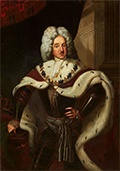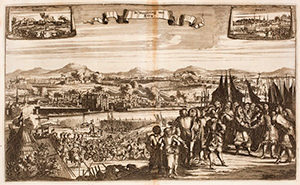Frederick I: King in Prussia
Frederick I was Elector of Brandenburg and Duke of Prussia in the early 18th Century. He also ushered in the Kingdom of Prussia. 
He was born on July 11, 1657, in Königsberg. His father was the reigning Duke of Prussia and Elector of Brandenburg, Frederick William, and his mother was Louise Henriette of Orange-Nassau. The boy was his parents' third son and so was not expected to follow in his father's political footsteps. However, his two older brothers died, William Henry in 1649 and Charles in 1674, and so Frederick at age 17 became the heir apparent. He grew up watching his father build up the Prussian army into a vaunted fighting force, defeating powerful Sweden multiple times, and also build up the Prussian interior, repairing the devastation of the Thirty Years War, concluded a decade before Frederick was born. Brandenburg Prussia was relatively at peace when Frederick William died, on April 29, 1688. At that point, Frederick assumed control. 
His father had sought an alliance with France's powerful "Sun King," Louis XIV. Frederick did not trust the French monarch and instead joined the League of Augsburg, a 1689 element of the larger Grand Alliance to contest French influence on the Continent. Prussian forces took part in the Alliance attack on French ally the Electorate of Cologne, which resulted in the eventual taking of the capital, Bonn. In the meantime, Frederick also sent Prussian troops to the Netherlands to protect against an uprising in the wake of his cousin William of Orange's crossing the English Channel to accept the English crown. Brandenburg Prussia had been effectively a vassal state of Poland. It was still officially under the auspices of the Holy Roman Empire, which did not allow kingdoms, except for the Kingdom of Bohemia, governed by the emperor himself. In 1701, Frederick, desiring a kingship, petitioned Emperor Leopold I to make an exception. Leopold agreed but with the caveat that Frederick would not be King of Prussia. Frederick agreed to become King in Prussia (an arrangement to appease other antagonists as well) and crowned himself as such on Jan. 18, 1701, in Königsberg. In return, Frederick agreed to fight with the Empire and its allies against Louis XIV in the War of the Spanish Succession, which had begun in 1700. Frederick sent 8,000 extra Prussian troops to the fighting, which lasted 13 long years. He had married Elisabeth Henriëtte of Hesse-Kassel in 1679. Their daughter, Louise Dorothea, arrived the following year. Elisabeth Henrëtte died of smallpox in 1683. The following year, Frederick married Sophia Charlotte of Hanover. They had two children, one of whom, Frederick William (1688), survived into adulthood. Sophia Charlotte died in 1705. Three years later, Frederick married Sophia Louise of Mecklenburg-Schwerin. They had no children. Frederick did not neglect internal improvements, founding a state arts academy in 1696 and a science academy four years after that. For major political matters, he looked to the guidance of prime minister Eberhard von Danckelmann, who was also Frederick's boyhood tutor (although jealousy of Danckelmann's power led his opponents to have him later arrested and discredited). Frederick I died on Feb. 25, 1713, in Berlin. His son, Frederick William, succeeded him. |
|
Social Studies for Kids
copyright 2002–2026
David White




